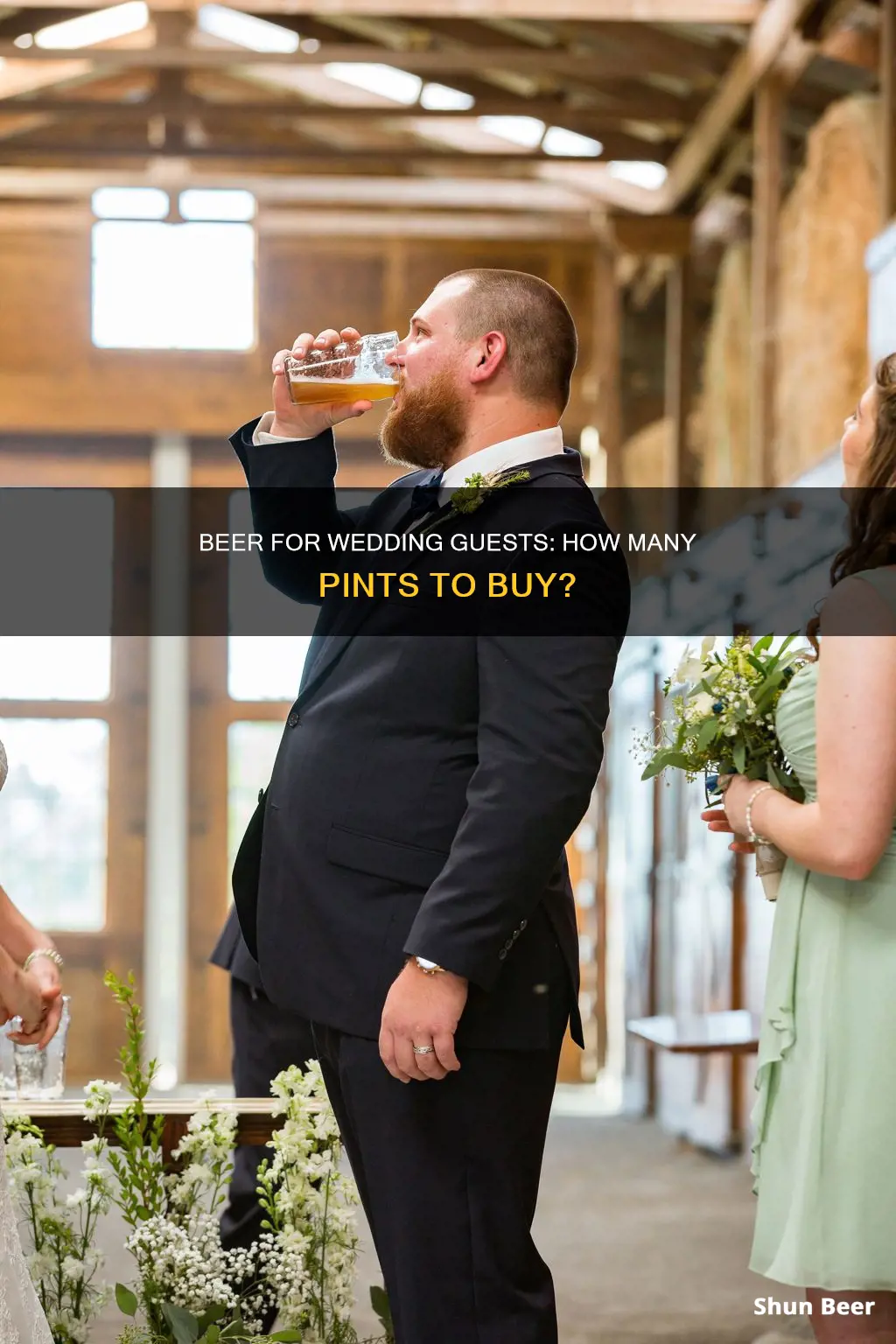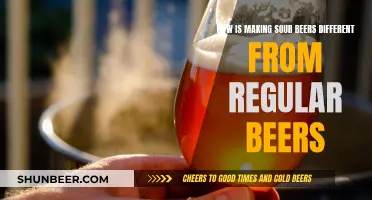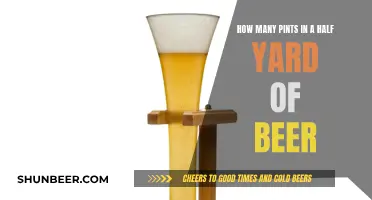
Planning a wedding can be stressful, especially when it comes to stocking the bar. A good rule of thumb is that a third of wedding guests will likely drink beer, a third will prefer wine, and the rest will consume spirits and non-alcoholic drinks. The number of drinks you need to serve also depends on the duration of your wedding and the drinking habits of your guests. For a typical 2-hour drinks reception, allow 3 drinks per guest. For the rest of the wedding, guests will consume about one drink per hour on average.
What You'll Learn

How much beer to buy for a wedding
Planning a wedding can be stressful, especially when it comes to stocking the bar. The amount of beer you need depends on several factors, including the number of guests, the duration of the reception, and the drinking preferences of your guests. Here is a comprehensive guide to help you determine how much beer to buy for your wedding.
Estimating Beer Consumption
As a general rule of thumb, about a third of wedding guests will likely drink beer, a third will prefer wine, and the rest will consume spirits and non-alcoholic drinks. It is recommended to plan for one drink per guest per hour of the reception. This may seem lower than expected, but consumption tends to slow down after the first hour.
Calculating Beer Requirements
To estimate the number of beers needed, you can use the following formula: Wedding beers = (Number of adult guests x Number of hours) / 3. For example, if you have 100 guests and a 4-hour reception, you would calculate: 100 x 4 = 400, then 400 / 3 = approximately 133 beers.
Adjusting for Guest Preferences
It is important to consider the drinking habits of your guests. If you know that a large portion of your guests are heavy beer drinkers, you should adjust your calculations accordingly. Additionally, the season may influence beer preferences, with crisper, floral beers like lagers and session ales being more popular in summer, and darker beers favoured in autumn and winter.
Buying and Serving Beer
When purchasing beer, buying in kegs may be more cost-effective, especially if many guests will be drinking beer. A standard keg typically contains up to 88 pints (53 glasses) of beer, and half kegs are also available. Alternatively, you can opt for individual bottles or cans, which are easier to store and transport.
Other Considerations
Don't forget to include non-alcoholic options for designated drivers, pregnant guests, and those who don't drink alcohol. It is recommended to over-order by 10-15% to ensure you don't run out, and to buy drinks on a sale-or-return basis so you can return any unopened boxes. Finally, don't forget to stock up on ice, mixers, and other essentials to keep your guests refreshed and happy!
IPA vs APA Beer: What's the Difference?
You may want to see also

How long is a wedding reception
When it comes to wedding planning, timing is everything. The length of a wedding reception can vary, but it typically lasts around four to five hours. This duration is considered standard in many regions, including the US, and provides ample time for cocktails, dinner, toasts, and dancing. However, it's worth noting that weddings in some cultures and regions can go on for much longer, sometimes extending into the early hours of the morning.
For a well-rounded wedding reception, a timeline is crucial. Here's a step-by-step breakdown to help you plan:
- Cocktail Hour (0:00-1:00): After the ceremony, guests proceed to the reception, where they can enjoy cocktails and appetizers. This is also when the bridal party and family typically take formal photos.
- Seating and Bridal Party Announcement (1:00-1:45): The wedding coordinator ensures everyone is seated before the bridal party and newlyweds make their grand entrance. The father of the bride traditionally welcomes the guests and gives thanks.
- Toasts (1:45-2:30): Once everyone has their food, it's time for toasts. The bride and groom may address the group, followed by the father of the bride, best man, and maid/matron of honour.
- First Dance and Special Dances (2:30-3:00): The bride and groom share their first dance as a married couple, followed by the father-daughter and mother-son dances.
- Open Dancing (3:00-4:00): The DJ or band kicks off the open dance floor session, inviting all guests to join. This is also the time for special traditions like the bouquet and garter toss.
- Cake Cutting (4:00-4:15): A brief pause in the dancing to cut the wedding cake. This is often done later in the evening, as some guests may leave afterward.
- Final Dancing and Last Call (4:15-4:45): Get back on the dance floor with upbeat music. The last dance is usually 15 minutes before the reception wraps up.
- Grand Exit (4:45): The newlyweds may choose to make a grand exit with sparklers or bubbles, or opt for a quiet slip-out.
When planning your wedding reception timeline, it's essential to consider the venue's package and coordinate with your wedding planner and venue coordinator. You can also adjust the timeline to accommodate your style, guests, and any unique traditions you want to include.
Now, let's talk about beer. When it comes to wedding beers, a good rule of thumb is to estimate that about a third of your guests will prefer beer. The general rule is to provide one beer per beer-drinking guest for each hour of the party. This means that for a four-hour reception with 100 guests, you'd need about 400 beers. You can also use the formula: Wedding beers = (No. of adult guests X No. of hours) / 3.
Remember to take into account the season and your guests' preferences when choosing the type of beer. Lighter, crisp beers like lagers and session ales are ideal for summer, while darker, maltier beers are better suited for autumn and winter. Providing a variety, such as a lager and a pale ale, is always a good idea.
People's Perceptions of Popular Beer Brands
You may want to see also

Beer vs. other drinks
When it comes to wedding drinks, there are a few options to consider: beer, wine, spirits, and cocktails. Each has its own advantages and disadvantages, and the right choice for your wedding will depend on your budget, the preferences of your guests, and the style of your wedding.
Beer
Beer is a popular choice for weddings, as it is typically less expensive than other types of alcohol. It is also more socially acceptable to drink beer at a wedding than hard liquor, and beer is often considered a more casual option that can help to create a relaxed and festive atmosphere. In addition, beer is usually served cold, which can be refreshing for guests, especially during summer weddings or weddings in warmer climates.
However, one potential downside of serving beer at a wedding is that it can be more filling than other types of alcohol, which may cause guests to eat less of the food that is served. Additionally, beer may not be the best choice for a more elegant or formal wedding, as it can be seen as less sophisticated than wine or cocktails.
Wine
Wine is another popular choice for weddings, and it is typically seen as more elegant and sophisticated than beer. It pairs well with food, so it can enhance the dining experience for your guests. Wine also comes in a variety of types and flavours, so it is easy to find options that will appeal to a wide range of tastes.
On the downside, wine can be more expensive than beer, and it may not be as refreshing for guests during warm weather. In addition, spilled wine can be difficult to clean up and may stain clothing or linens.
Spirits
Spirits, such as vodka, rum, and bourbon, are often served at weddings, especially if the couple wants to offer a full bar. Spirits can be used to create a variety of cocktails, which can add a fun and personalised touch to the wedding.
However, spirits can be more expensive than beer or wine, and they may not be the best choice for a casual or daytime wedding. In addition, hard liquor can lead to drunkenness more quickly than other types of alcohol, which may not be the atmosphere you want to create at your wedding.
Cocktails
Cocktails can be a fun and unique addition to a wedding, especially if you create signature cocktails that reflect the personalities of the couple or tie into the wedding theme. They can also be a good option for guests who do not typically enjoy the taste of alcohol, as cocktails can be made with fruit juices, sweeteners, and other flavourings that mask the taste of the liquor.
However, cocktails can be more time-consuming to make than simply pouring a glass of wine or beer, and they may require additional ingredients and equipment that can add to the cost. In addition, guests who are particular about their drinks may be disappointed if the bartender does not make the cocktail to their exact specifications.
In conclusion, each type of drink has its own advantages and disadvantages, and the best choice for your wedding will depend on a variety of factors. However, by considering your budget, the preferences of your guests, and the style and atmosphere you want to create, you can choose the perfect drinks to help make your wedding a success.
Exploring Beer Measurements: Mils and Pints
You may want to see also

Buying beer in kegs
When it comes to buying beer in kegs for a wedding, there are a few things to consider. Firstly, the number of guests and their drinking preferences will determine how many kegs you'll need. A typical keg holds 50 litres or around 88 pints of beer, and you can also buy half-kegs. As a rule of thumb, about a third of wedding guests will likely drink beer, a third will prefer wine, and the rest will consume spirits and non-alcoholic drinks.
If you're having a smaller, intimate wedding, buying by the bottle or can may be more cost-effective as it allows for more variety and reduces waste. Bottled or canned beer is also a good option if your wedding is in a hard-to-reach spot or if you don't want the expense or hassle of setting up a draft system. Additionally, if you're hiring a rookie bartender, bottles are a safer choice as they're easier to serve.
However, if you're having a large number of guests and expect a lot of beer drinkers, kegs may be a more economical choice. They also create less waste than individual bottles or cans, especially if you're serving beer as the main drink option.
When deciding between bottles, cans, or kegs, it's important to consider the bar environment you want to create. Glass bottles may not be the best choice if you plan on having a packed dance floor, as they can be less safe and more difficult to dispose of than plastic cups.
To estimate how many kegs you'll need, use the following formula:
> Wedding beers = (No. of adult guests X No. of hours) / 3
For example, if you have 100 guests and your wedding lasts 4 hours, you'll need approximately 133 beers, which would be just over one and a half kegs.
It's always better to overestimate than underestimate, as running out of drinks during the event is a common concern. Plus, you can always stock your home bar with any leftover beer!
Swapping Beers for Vodka: Half-Pint Conundrum
You may want to see also

Beer and non-alcoholic drinks
When it comes to beer and non-alcoholic drinks for a wedding, there are a few things to consider to ensure you have enough drinks for your guests.
Firstly, it's important to estimate how many guests will be drinking beer. As a rule of thumb, about a third of wedding guests will likely drink beer, a third will prefer wine, and the rest will consume spirits and non-alcoholic drinks. Of course, you know your guest list best, so adjust this estimate accordingly if many of your attendees are big beer drinkers.
Next, you'll want to calculate the duration of your wedding. The average wedding reception is four to five hours long, and guests will consume about one drink per hour on average. This might seem less than you'd expect, but keep in mind that drinking tends to slow down after the first hour and during activities like meals, speeches, and dancing.
Using the formula:
> Wedding beers = (No. of adult guests X No. of hours) / 3
You can estimate the number of beers needed for your wedding. For example, a wedding with 100 guests and a four-hour reception would require approximately 133 beers.
- 30 guests: 40 beers
- 50 guests: 67 beers
- 100 guests: 133 beers
- 150 guests: 200 beers
- 200 guests: 267 beers
When choosing the type of beer, consider the season. Crisper, more floral-flavoured beers like lagers and session ales are better suited for summer, while darker beers and maltier flavours are more popular in autumn and winter. It's a good idea to provide a variety, especially if you're catering to a large number of guests. Aim to offer at least two different styles of beer, such as one lager and one pale ale.
In addition to beer, it's essential to provide non-alcoholic options for those who are underage, pregnant, or prefer not to drink alcohol. Some non-alcoholic alternatives include:
- Soft drinks: A 2-litre bottle of soft drink will typically provide 20 x 100ml measures. Offer a variety of options, such as elderflower, pink lemonade, apple juice, and sparkling water.
- Mocktails: These are non-alcoholic cocktails that can be as creative and tasty as their alcoholic counterparts. Consider options like a Shirley Temple or use new non-alcoholic spirits on the market.
- Non-alcoholic beer and gin: There are now several non-alcoholic beers and gins available, providing an excellent alternative for those who want the taste without the alcohol.
Remember to cater to various preferences and dietary restrictions when choosing non-alcoholic drinks. It's also a good idea to over-order by 10-15% to ensure you don't run out, and buy drinks on a sale-or-return basis so you can return any unopened boxes.
How an Extra Pint of Beer Affects Your Body
You may want to see also
Frequently asked questions
It depends on the number of guests and the duration of the reception. A good rule of thumb is to provide one beer per guest per hour of the party.
Multiply the number of beer drinkers by the number of hours the reception will last. For example, if you have 50 guests who drink beer and your reception lasts 4 hours, you will need 200 beers.
Consider the drinking preferences of your guests, the time of year, and the duration of the reception. If many guests are beer drinkers, you may want to buy kegs, which offer better value for money.
A standard 11-gallon keg holds 88 pints of beer. You can also buy half kegs containing around 44 pints.
Assume that each guest will have 6-8 drinks during a 4-hour party. If you have 100 guests and only want to serve beer and wine, you will need around 300 pints/bottles of lager, beer, and cider.







